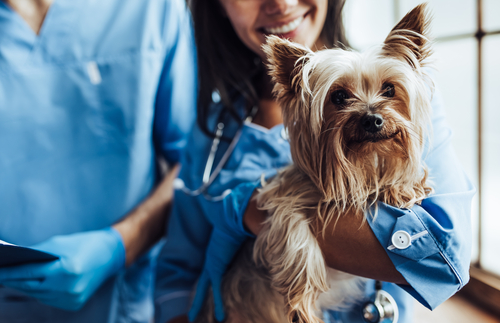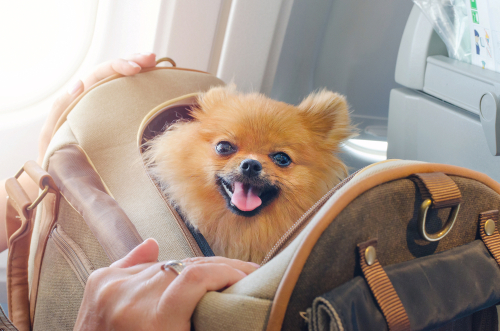Regardless of how many miles you’ve accumulated in your lifetime, you may have some questions about specific airline policies — particularly when it comes to pets. According to Starwood Animal Transport Services, an estimated two million pets travel on planes in America each year. There are countless reasons these pets might take to the friendly skies, from making a big move to acting as a certified service animal.
To make your next trip with your furry friend more enjoyable, here are six dog air travel tips to keep in mind before you board the plane to make sure everyone is ready.
1. Go to the Vet Shortly Before Flying
Before you embark on your upcoming trip, bring your pup to the vet a couple of weeks before so they can have a thorough examination to ensure they are ready for air travel and have every vaccination they might need. The vet can also help you discuss any concerns you might have about the trip. If your dog has a particularly nervous disposition, this is the time to ask your vet about possible sedation options and whether they make sense for him or her.
A trip to the vet will also help you secure a health certificate if you need one. Depending on where you are going, such as Hawaii, you might need a certificate of health issued within a few days of your travels. Therefore, you want to schedule your appointments accordingly so you have the proper documentation for your trip.

2. Avoid Layovers and Book Early
If you plan to fly with your dog, be sure to book your flight early so you can get the flight you want. You’ll want to schedule a direct flight to make the trip as easy as possible on your pet, which can make it more challenging to find an optimal flight option. Flights will often restrict the number of pets that can fly on a given plane, which means that you’ll need to make sure you schedule your desired flight as quickly as possible so you and your dog get a guaranteed seat. Typically, the earliest you can book a flight is 11 months in advance.
3. Know Your Airline’s Pet Policies
Before you schedule your flight, you will also want to carefully review the airline’s animal flight policies, such as dogs sitting with you in the cabin. If your dog qualifies, familiarize yourself with the guidelines and restrictions so you can make the flight as comfortable as possible for yourself, your pet, and those around you. The rules may also differ for pets versus service dogs or emotional support animals.
You might also find differences between domestic flights within the United States and international travel when it comes to dog restrictions. For international flights, be sure to check the rules of the countries you will visit. Many major airlines, like Delta, Southwest, and American Airlines, have a dedicated webpage for FAQs regarding pet travel.

You’ll also want to take a closer look at an airline’s policy regarding dogs that ride in the cargo hold before you reach the check-in counter. Understand what they take responsibility for and what will happen to your dog in the event of a delay or other unexpected obstacle. This can help you feel comfortable with their policies and set up your dog’s accommodations as optimally as possible for the flight.
4. Watch Out for Restricted Breeds
Some airlines will restrict flights for certain breeds, particularly those who have shorter airways or breathing problems, such as a Pug. Some commonly restricted dog breeds include:
- Pit Bulls
- Boston Terriers
- Shih Tzus
- Pekingese
- Boxers
- Mastiffs
- Bulldogs
5. Make Your Dog as Comfortable as Possible
Even after every concession has been made, the truth is that flying can be a stressful experience for your dog. Smaller dogs that can be carried aboard and certified service dogs that can sit at your feet might have a better time than dogs delegated to the cargo hold. But even they have to contend with a series of disorienting noises, smells, and people, not to mention changes in air pressure and cabin temperature, and a limited ability to relieve themselves.
When you travel with your dog, remember that they will be confined to their kennel for the duration of the trip regardless of whether they are small enough to travel as a carry-on or if they have to get checked at the gate. Therefore, you will want to make sure that your dog has enough space during the trip and that they are used to being in the kennel.
Here are some ways to get your dog used to their new travel carrier:
- Get the kennel well in advance of the trip. You want to give your dog plenty of opportunities to get used to the crate or pet carrier and develop positive associations with it.
- Provide your dog with plenty of opportunities to comfortably use their kennel before the trip. This can include feeding them inside it or putting their bed in there with the door open so they associate it with relaxation and sleep.
- Help the dog get used to the sounds and commotion they might encounter throughout the flight. For example, you can use recordings of planes taking off or the constant murmur of voices and interruptions to help them learn to dismiss the sounds as background noise.
- Make sure your dog is fully crate trained before the trip. Most dogs are crate trained, but you want to make sure that your dog knows how to safely and comfortably lie in their crate for extended periods before they are confined during a flight. In the chance that they aren’t crate trained before the trip, some owners find it helpful to line the bottom of the kennel with an absorbent puppy pad in case the dog has any accidents during the flight.
- If you have a layover, have a plan to help your dog stretch their legs if at all possible. Take turns with family members to walk the dog and find a designated area for them to use the restroom. It’s best to familiarize yourself with the layouts of the airports you will be traveling through.
- Include something in the kennel that has a scent familiar to the dog. Many dogs find it comforting if you give them a shirt or article of clothing that smells like you. This can help them remain calm in any new environment and during takeoff and landing.
6. Prep Your Dog Before the Flight
On the day of the trip, you want to do everything in your power to make your dog feel relaxed and prepared. This preparation will start early on the day you leave.

Pre-flight Prep Tips for Your Pup:
- Make sure your dog gets plenty of exercise before you leave. You will want to take them for a very long walk and maybe give them the chance to run around before you leave for the airport. This is true even if you have a morning flight. Get up a few hours before you have to leave for the airport and make sure that providing your dog with ample exercise is a priority. Once they are in the crate, they will be there for hours. You want them in a condition that will encourage them to rest and even sleep during the trip.
- Before heading to the airport, provide your pet with multiple opportunities to go to the bathroom. Then, when you arrive at the airport, familiarize yourself with the locations of grassy areas or even designated pet-relief areas in the airport. Note the ones closest to your terminal and try to give the dog one more opportunity to go before getting on the plane.
- Monitor how much food and water your pet has before the flight. Of course, you do not want your dog to get hungry or dehydrated during the trip, but you also do not want them to have to go to the bathroom urgently halfway through the flight and have nowhere to go. Generally speaking, try to feed the dog a good meal several hours before the trip and keep them hydrated. Having some extra food and water on hand for the flight can also be a good idea just in case unexpected delays arise during the trip.
Find a Dog-Friendly Vacation Rental
Whether you have travel plans and want to bring your doggo along to experience the vacation or you’re moving somewhere new, flying with your dog does not have to be overwhelming. If a getaway just doesn’t feel the same without your trusted companion by your side, why not bring them along? We have designed our search engine with filters that can find the perfect dog-friendly rental for you both!